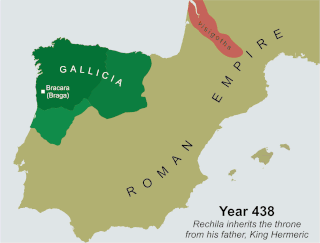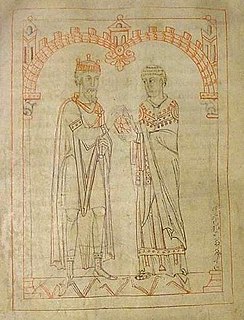Notes
| Preceded by Maldras | King of Galicia 464–469 | Succeeded by Theodemund |
Remismund (or Rimismund) (died 469) was the Suevic king of Galicia from c. 464 until his death.
According to Isidore of Seville, Remismund was a son of Maldras. [1] Remismund's early career was spent as an ambassador between Galicia and Gaul, which trip he made several times. [2] After an interregnum of approximately four years (460–464), during which the Sueves who had previously recognised Maldras as king were led by Frumar and those who had recognised Framta followed Rechimund while both their leaders fought for the throne, Remismund, returning from one of his embassies, succeeded in having himself recognised as king of a unified Suevic people. [2] This occurred after Frumar's death, but scholars are not certain of the significance of that statement. [2] Had Frumar become sole king? Or did Remismund initially succeed Frumar only over part of the Suevic nation? Furthermore, Remismund is sometimes identified with Rechimund. [2]
Remismund was confirmed in the kingship when the Visigothic monarch, Theodoric II, sent him gifts, including weapons, and a Gothic princess for a wife. [3] The involvement of Theodoric in the succession of Remismund has, however, been exaggerated by Jordanes, who claims that after the Gothic king put down the revolt and usurpation of Aioulf, he allowed the Suevi to elect a king of their own, and they chose Remismund. [3] In 466, on the authority of Hydatius, Theodoric sent an envoy, Salla, to the court of Remismund. [4] Remismund may have sent one Palagorius, a noble Galician, as an envoy to Theodoric, but it is possible that Palagorius went on a private mission. [5]
In 465 he sacked Coimbra or Conímbriga and in 468 destroyed it, plundering the goods of a noble family called the Cantabri. [6] In 469 the city of Lisbon was betrayed to the Suevi by a native Roman named Lusidius. Also in 469 Remismund began negotiations with the Roman Emperor Anthemius through a large embassy of Sueves led by Lusidius. [5]
In 466 he requested an Arian missionary from the Gothic court and received Ajax, a Gaul or Galatian, who converted the Suevic nobility and established an Arian church in Galicia. [7]
| Preceded by Maldras | King of Galicia 464–469 | Succeeded by Theodemund |

The Suebi were a large group of Germanic peoples originally from the Elbe river region in what is now Germany and Czechia. In the early Roman era they included many peoples with their own names such as the Marcomanni, Quadi, Hermunduri, Semnones, and Lombards. New groupings formed later such as the Alamanni and Bavarians and two kingdoms in the Migration Period were simply referred to as Suebian.

The 460s decade ran from January 1, 460, to December 31, 469.

Year 464 (CDLXIV) was a leap year starting on Wednesday of the Julian calendar. At the time, it was known as the Year of the Consulship of Rusticus and Olybrius. The denomination 464 for this year has been used since the early medieval period, when the Anno Domini calendar era became the prevalent method in Europe for naming years.
This is a historical timeline of the Iberian Peninsula during the period of the Germanic kingdoms.
Hermeric was the king of the Suevi in Galicia from perhaps as early as 406 and certainly no later than 419 until his retirement in 438. He was a pagan and an enemy of the Roman Empire throughout his life. He is given a reign of thirty-two years in most manuscripts of Isidore of Seville's Historia Suevorum, but one manuscript does list his reign as fourteen years.

Rechila was the Suevic King of Galicia from 438 until his death. There are few primary sources for his life, but Hydatius was a contemporary Christian (non-Arian) chronicler in Galicia.
Rechiar or Rechiarius was the Suevic king of Gallaecia from 448 until his death. He was the first Chalcedonian Christian (Catholic) Germanic king in Europe and one of the most innovative and belligerent of the Suevi monarchs. Despite his orthodox Christianity, Hydatius, the contemporary bishop and chronicler from Galicia who is the sole contemporary source for biographical details of Rechiar, established his reputation as that of a barbarian with little sense of Roman law, culture, or custom.
Maldras was the Suevic King of Galicia from 456 until his death. After the execution of Rechiar by the victorious Visigoths, the Suevi are said to have established Maldras on the throne. During his reign the Suevic nation became fragmented.
Theodemund was a Suevic King of Galicia between the years 469 and 550. This period is very obscure and little is known about the rulers in this time save that they were Arians. The hypothesis of his existence is based on a twelfth-century document that mentions a Theodemundus ruling the Sueves between Remismund and Theodomir. Because this mention occurs in a listing of seventh-century ecclesiastical divisions at the time of Wamba, Wilhelm Reinhart believes it was based on an earlier source.

The Kingdom of the Suebi, also called the Kingdom of Gallæcia or Suebi Kingdom of Gallæcia, was a Germanic post-Roman kingdom that was one of the first to separate from the Roman Empire. Based in the former Roman provinces of Gallaecia and northern Lusitania, the de facto kingdom was established by the Suebi about 409, and during the 6th century it became a formally declared kingdom identifying with Gallaecia. It maintained its independence until 585, when it was annexed by the Visigoths, and was turned into the sixth province of the Visigothic Kingdom in Hispania.
Aioulf or Ag(r)iwulf was an obscure King of Galicia from 456. In 448, after eight years in captivity, the Roman ambassador Censorius was executed by one Agiulf at Seville (Hispalis). This Agiulf has sometimes been identified with Aioulf.
Framta, Framtan or Framtane was one of the kings of the Suevi in Galicia in 457.
Richimund or Rechimund was a Suevic leader in Galicia from 457 until about 464. He was not recorded as a king (rex), though Hydatius wrote that inter Frumarium et Rechimundum oritur de regni potestate dissensio. In 457 the Suevi split into two factions, one headed by Maldras raiding Lusitania and another led by Framta remaining in Galicia. After a few months of rule, Framta died and Rechimund appeared as his successor. While it is possible that the Suevi were living under a diarchy, it is more likely that the two factions remained independent of one another. Maldras' eventual successor, Frumar, was also not described as a king, but in 464 or thereabouts the entire Suevic nation was unified under a king named Remismund. Presumably, Rechimund and Frumar had battled for the throne and both had been eliminated, paving the way for Remismund. Some scholars have equated Remismund with Rechimund, but this seems far-fetched.
Frumar was a Suevic warlord who succeeded Maldras, as leader of the Suevic group then raiding Lusitania. He probably competed with Rechimund, the Suevic war leader in Gallaecia, for the throne until his death.

Miro was the Suebian King of Galicia from 570 until his death in 583. His reign was marked by attempts to forge alliances with other Chalcedonian Christian nations with the goal of checking the power of the Arian Visigoths under Leovigild. During his reign relations were established with both Francia and the Byzantine Empire and the kingdom reached its zenith, but it collapsed within three years of his death.
Audeca or Andeca was the last Suevic King of Galicia from 584 until his deposition in 585. He deposed Eboric and usurped the throne by marrying the young king's mother, Siseguntia, the widow of Eboric's father and predecessor, Miro. He consigned Eboric to a monastery.

Ariamir was the Suevic King of Galicia, with his capital at Bracara, from 558/9. The bishops of the First Council of Braga recorded Ariamir as the king who summoned them and under whose auspices they deliberated. Because the bishops mention theirs as being the first Nicene synod to be held in Galicia in a long while, Ariamir is sometimes assumed to have been the king who led the conversion of his people from Arianism to orthodoxy and thus to have lifted the ban on Nicene councils.
Ajax was an Arian missionary to the pagan Suevi of Galicia who converted them to Christianity in 464 or 466.
Hermeneric was a Suevic King of Galicia according to a now lost document described by the priest Antonio de Yepes. According to Yepes, the king reigned around 485, which falls within a century-long period (469–c.560) of obscurity during which the Sueves were predominantly Arian Christians. Hermeneric was said to be a destroyer of churches and persecutor of Catholic Christians.
Veremund or Veremundus was a Suevic king of Galicia around 500. His existence is conjectured on the basis of a sixth-century inscription discovered at Salvador de Vairão. The date in the inscription is interpreted as either 485 or 535. Some scholars have dated the inscription to the eighth century, arguing that the Veremundus of the inscription is King Bermudo I of Asturias.